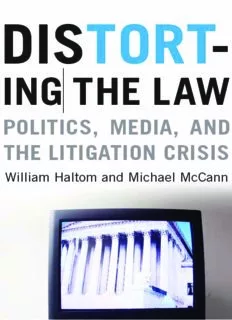
Distorting the Law: Politics, Media, and the Litigation Crisis PDF
Preview Distorting the Law: Politics, Media, and the Litigation Crisis
00-C2995-FM 6/25/04 5:49 AM Page i d i s t o r t i n g t h e l aw 00-C2995-FM 6/25/04 5:49 AM Page ii the chicago series in law and society Edited by William M. O’Barr and John M. Conley 00-C2995-FM 6/25/04 5:49 AM Page iii d i s t o r t i n g t h e l aw Politics, Media, and the Litigation Crisis william haltom and michael mccann the university of chicago press Chicago and London 00-C2995-FM 6/25/04 5:49 AM Page iv william haltomis a professor in the Department of Politics and Government at the University of Puget Sound. He is the author of Reporting on the Courts: How Mass Media Report Judicial Actions(1998). michael mccannis the Gordon Hirabayashi Professor for the Advancement of Citizenship and director of the Comparative and Society Studies Center at the University of Washington, Seattle. He is the author of Taking Reform Seriously: Perspectives on Public Interest Liberalism(1986) and Rights at Work: Pay Equity Reform and the Politics of Legal Mobilization(1994), the latter published by the University of Chicago Press; he is also a coeditor of Judging the Constitution: Critical Essays on Judicial Lawmaking,with Gerald L. Houseman (1989). The University of Chicago Press, Chicago 60637 The University of Chicago Press, Ltd., London © 2004 by The University of Chicago All rights reserved. Published 2004 Printed in the United States of America 13 12 11 10 09 08 07 06 05 04 1 2 3 4 isbn:0-226-31463-4 (cloth) isbn:0-226-31464-2 (paper) Library of Congress Cataloging-in-Publication Data Haltom, William. Distorting the law : politics, media, and the litigation crisis / William Haltom and Michael McCann. p. cm.—(The Chicago series in law and society) Includes bibliographical references and index. isbn0-226-31463-4 (cloth : alk. paper)—isbn0-226-31464-2 (pbk. : alk. paper) 1. Actions and defenses—Press coverage—United States. 2. Torts—Press Coverage—United States. 3. Law in mass media—United States. 4. Law and politics. 5. Sociological jurisprudence. I. McCann, Michael J. II. Title. III. Series. kf380.h35 2004 346.7303—dc22 2004001268 (cid:2)(cid:2) The paper used in this publication meets the minimum requirements of the American National Standard for Information Sciences—Permanence of Paper for Printed Library Materials, ansi z39.48-1992. 00-C2995-FM 6/25/04 5:49 AM Page v From Michael, to Donna, with love and devotion always From Bill, to three women who agreeably but insistently speak their minds: Patricia Anderson, Carolyn Haltom, and Karen Porter 00-C2995-FM 6/25/04 5:49 AM Page vi 00-C2995-FM 6/25/04 5:49 AM Page vii Contents Preface ix 1. The Social Production of Legal Knowledge 1 part one: contesting legal realities 2. Pop Torts: Tales of Legal Degeneration and Moral Regeneration 33 3. In Retort: Narratives versus Numbers 73 4. ATLA Shrugged: Plaintiffs’ Lawyers Play Defense 111 part two: reporting legal realities 5. Full Tort Press: Media Coverage of Civil Litigation 147 6. Java Jive: Genealogy of a Juridical Icon 183 7. Smoke Signals from the Tobacco Wars 227 8. Law through the Looking Glass of Mass Politics 265 References 307 Index 329 00-C2995-FM 6/25/04 5:49 AM Page viii 00-C2995-FM 6/25/04 5:49 AM Page ix Preface This book began with a casual conversation about the much-publicized McDonald’s coffee case. Our common interest in the curious case no doubt reflected in part our mutual ties to the University of Washington, where one of us (Haltom) finished up a Ph.D. and the other (McCann) started out as an assistant professor at about the same time. Both of us participated in a vibrant intellectual community of scholars at UW interested in law and society, mass media, and political culture. We were each especially inter- ested in how legal knowledge, and hence law itself, is constructed and produced in modern mass-mediated culture. At the same time, our quite different types of previous research provided us varying angles on the sub- ject. One of us, Haltom, had undertaken extensive study concerning news- paper coverage of judicial action; he was skilled at compiling and parsing statistical data sets, and given to fretting over how to make his method- ologicalcutsintoempiricalrealityassharpaspossible.Theother,McCann, specialized in theory-driven, qualitative, interpretive studies of legal mo- bilization and disputing by social movements and individuals; he reveled in exploring the elusive topic of legal consciousness. While we each strad- dled the fence dividing rival approaches to social constructionist analysis, Haltom leaned a bit more toward the realist, positivist side while McCann tilted more consistently to the post-structuralist and post-positivist side. Both of us were inclined to be detail-oriented, but we assessed and ob- sessed about details very differently. Our discussions progressively clari- fied these differences as well as the commonalities of intellectual style and understanding that fused into our common project. Eventually a general question emerged: How did it come about that prominent elites—politicians, media pundits, news reporters, celebrities, comedians, cartoonists, film makers, novelists, and other producers of mass culture—routinely blame a myriad of social ills on an epidemic of
Description: